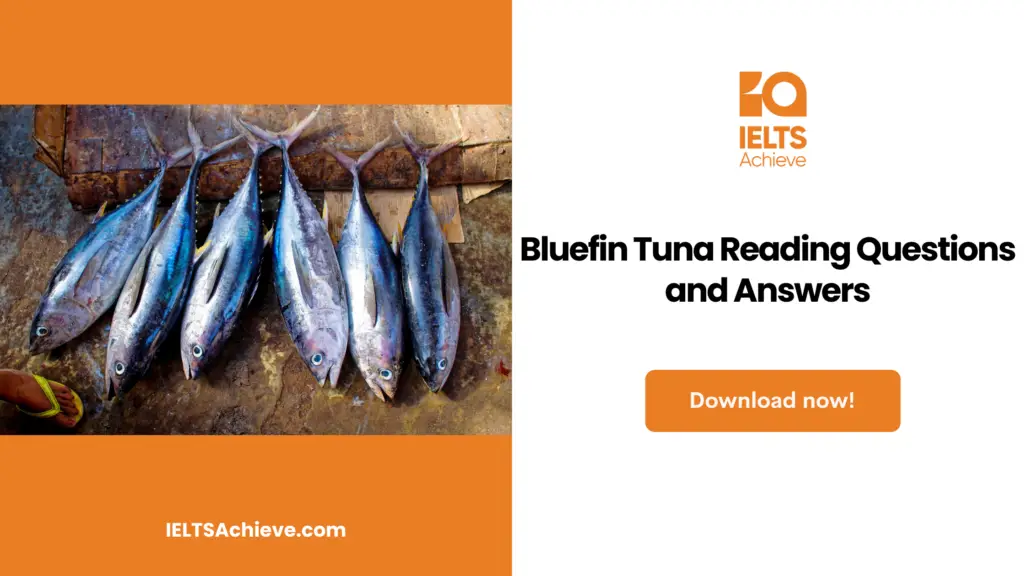The Blog post contains the following IELTS Reading Questions:
- IELTS Reading Summary Completion
- IELTS Reading Sentence Completion
- IELTS Reading Matching Sentence Endings
Stay informed and prepared for success – Explore our comprehensive Reading Test Info page to get valuable insights, exam format details, and expert tips for mastering the IELTS Reading section.
IELTS Reading passage –Bluefin Tuna

Bluefin Tuna
Three species of bluefin tuna are found around the world – Northern or Atlantic bluefin tuna, Southern bluefin tuna and Pacific bluefin tuna. Atlantic bluefin tuna is divided into two stocks.
The western stock is harvested off the coast of North America by Canada, Japan, and the United States, and the eastern stock is harvested off the coast of Europe and Africa and in the Mediterranean Sea.
Fisheries for bluefin tuna date back thousands of years in the Mediterranean, but did not emerge in the western Atlantic until the 1950’s. Although today they are widely known as the most prized species of tuna, there was no commercial market for western Atlantic bluefin tuna until then. In fact, fishermen regarded giant bluefin tuna as a nuisance because of the damage they caused to fishing gear. However, as sushi and sashimi markets in Japan developed in the 1970’s and 1980’s, the demand and prices for bluefin tuna increased and so did fishing pressure around the world.
Since bluefin tuna are late to mature, slow growing, and long-lived, they are especially susceptible to fishing pressure, compared to faster growing, more productive species. Bluefin tuna grow more slowly than other tunas and have a long life span, up to 20 years or more, and generally do not spawn until they are about eight years old. Because many nations harvest bluefin tuna, effective conservation and management of this resource depend on strong international cooperation. The United States has taken many steps to conserve and manage US fisheries for Atlantic bluefin tuna since the early 1980’s. It is due in part to these measures and US efforts internationally that Atlantic bluefin tuna are no longer subject to overfishing.
Today, international fisheries for western Atlantic bluefin tuna are highly regulated. The most recent annual catch level set is expected to support continued growth and recovery of the stock. Strict controls are in place to ensure compliance, on the water, in port, and at the marketplace, through the implementation of the catch documentation scheme, which allows trade tracking for individual shipments of fish.
Finally, because the western and eastern stocks mix, western Atlantic bluefin tuna are also affected by the fishing pressure in the eastern Atlantic that took place in the eastern Atlantic/ Mediterranean during the 1990’s and early 2000’s. However, in recent years, catches in the eastern Atlantic have been reduced to levels consistent with scientific advice, and new monitoring and control measures have been adopted to address illegal, unreported and unregulated fishing on that stock. Scientists advise that improved stock conservation in the eastern Atlantic would likely benefit the western stock as well.
The news is not so good for bluefin tuna in other parts of the world. Data recently released shows that there is almost no more bluefin tuna to be fished in some of the oldest fishing grounds, especially in the West Mediterranean. Around Spain’s Balearic Islands, catches of bluefin tuna are down to only 15 percent of what they were just a decade ago. In Australia, there is a similar story and the southern bluefin tuna stock is at historically low levels, with less than 10 per cent of the virgin stock left, and little significant progress in preventing the overharvesting that is driving the species further towards extinction.
Because of the value of bluefin tuna, scientists are trying to work out ways of farming the species. The vision is to have huge tanks, land-based, having bluefin tuna that are spawning year-round on demand, producing millions of eggs. These eggs would hatch and grow into a plentiful supply of tuna. There are, however, problems associated with rearing bluefin tuna. First of all, the larvae that hatch from the eggs are extremely fragile. Because of their heavy heads, the larvae tend to go downwards. If they hit the bottom of a tank, the shock is too much and they do not survive. After this, a significant problem is the appetite of the bluefin tuna. A bluefin tuna’s natural diet consists of lots of other fish. Just supplying the amount of fish needed for bluefin tuna to grow would be difficult and expensive, without even considering the harm to the environment of taking that many wild feed fish from the sea. Right now, there are tuna ranches that capture young tuna in the ocean and then fatten them up in big net-pens. These ranches feed their tuna about 15 pounds of fish, such as sardines or mackerel for each additional pound of tuna that can be sold to consumers. This kind of tuna production is environmentally costly.
Some scientists have theorised that it will be possible to reduce this ratio or even create tuna feed that does not rely so heavily on other fish as an ingredient. The effect on the taste of the bluefin tuna’s flesh though may make the product less valuable and destroy the whole point of producing bluefin tuna cheaply.
Other experts say that these problems show that bluefin tuna farming is not the path to follow, as farming bluefin tuna just increases the population of a predator species that demands lots of food itself. It might do more good to eat a little lower on the marine food chain. People could eat more mussels or sardines and let more tuna roam free to be sustainably caught within quota systems and premium-priced.
Unlock your full potential in the IELTS Reading section – Visit our IELTS Reading Practice Question Answer page now!
Recommended Questions:
Renewable Energy IELTS Reading Question with Answer
Questions 14-16
Complete each sentence with the correct ending (A – E) below.
Write the correct letter (A – E) in answer boxes 14-16 on your answer sheet.
14 Bluefin tuna were not widely fished for outside the Mediterranean in the 1940’s, because
15 Fishermen in the past did not want to catch bluefin tuna, because
16 Bluefin tuna are extremely vulnerable to overfishing, because
A they take a long time to grow to adulthood.
B the fish damaged their equipment.
C the fish are not found in freshwater.
D the fish were suspected to cause various types of cancer.
E there was no significant market for them.
Questions 17-21
Complete the sentences below.
Write NO MORE THAN THREE WORDS AND/OR A NUMBER from the text for each answer.
Write your answers in boxes 17-21 on your answer sheet.
17 …………… between the relevant countries will be needed if bluefin tuna resources are to be managed in a sustainable fashion.
18 Any caught bluefin tuna can be tracked in North America due to the use of the ……………..
19 ………….. in the eastern stocks has affected the numbers of the western Atlantic bluefin tuna.
20 Bluefin tuna catches are down to …………….. of what they were previously near the Balearic Islands.
21…………… is a real danger due to the overharvesting of the southern bluefin tuna.
Enhance your sentence completion skills in the IELTS Reading section. Click here to access our comprehensive guide and learn effective strategies for filling in missing words or phrases in sentences.
Questions 22-26
Complete the summary using the words in the box below.
Write your answers in boxes 22-26 on your answer sheet.
FARMING BLUEFIN TUNA
Scientists are working on how to develop large-scale bluefin tuna farms to rear them from egg
to adults, with fish 22…………….. all year. Obstacles are the 23…………….. of bluefin larvae, which
means they die easily, and the amount of fish needed to feed them until they reach harvest
size. Some operating farms capture 24………….. to feed up, but this too is environmentally
damaging.
One solution is that a non-fish based feed can be used, but this may affect the product’s taste.
It could be that bluefin tuna are not meant to be farmed and that people should eat fewer
25…………. fish and allow the bluefin tuna to become a 26…………….. meal.
eggs fragility protecting strength sea
reproducing luxury juveniles simple predatory
Boost your performance in Summary, Notes, Table, and Flowchart Completion tasks. Click here to explore our detailed guide and learn how to effectively complete summaries, notes, tables, and flowcharts in the IELTS Reading section.
Unlock your full potential in the IELTS Reading section – Visit our IELTS Reading Practice Question Answer page now!
Recommended Questions:
Renewable Energy IELTS Reading Question with Answer
Answers
14Answer: E
15Answer: B
16Answer: A
17Answer: (strong) (international) co-operation
18Answer: (catch) documentation scheme
19Answer: (fishing) pressure
20Answer: 15%
21Answer: extinction
22Answer: reproducing
23Answer: fragility
24Answer: juveniles
25Answer: predatory
26Answer: luxury

We hope you found this post useful in helping you to study for the IELTS Test. If you have any questions please let us know in the comments below or on the Facebook page.
The best way to keep up to date with posts like this is to like us on Facebook, then follow us on Instagram and Pinterest. If you need help preparing for the IELTS Test, join the IELTS Achieve Academy and see how we can assist you to achieve your desired band score. We offer an essay correction service, mock exams and online courses.

